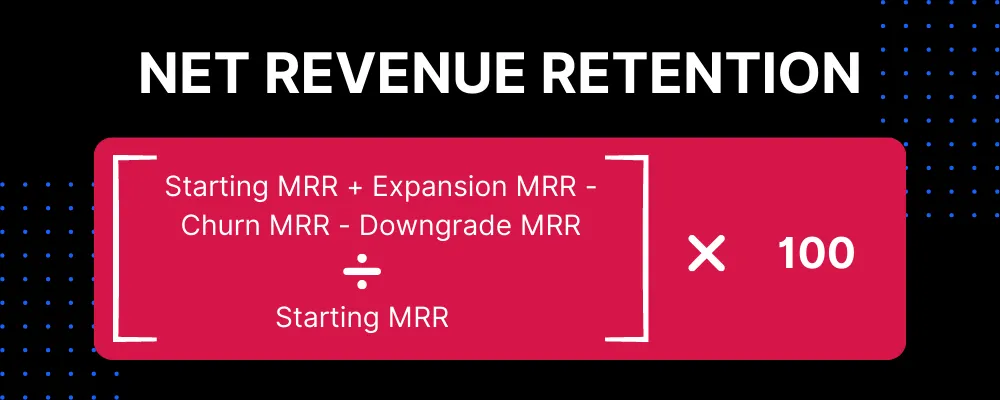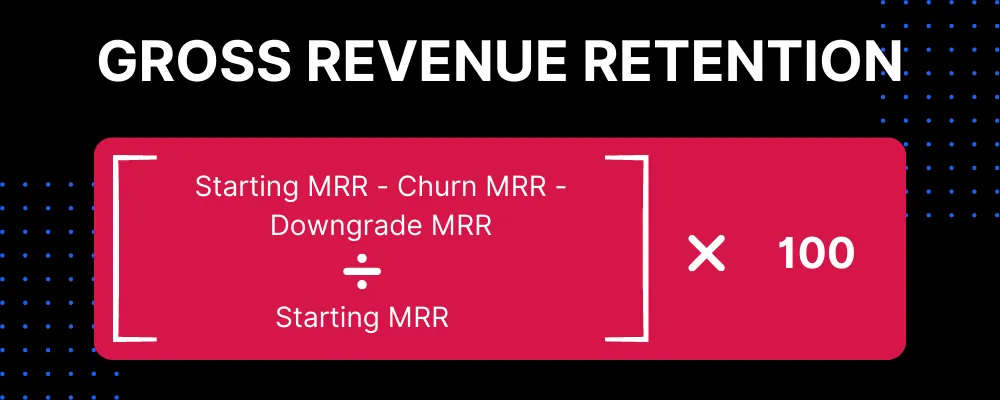
Are you a growth-minded SaaS company wanting to increase revenue but seeing a lot of churn or downgrades in your existing customer base?
NRR can help.
Net revenue retention (NRR) is an important metric for subscription-based businesses. Sometimes called net dollar retention (NDR), this SaaS metric has gained popularity with the shifted focus toward retention and expansion-fueled growth—including among enterprise SaaS.
Unlike monthly recurring revenue (MRR), NRR considers only your existing customers to determine revenue stability—meaning that high acquisition rates can’t disguise churn or mislead your long-term growth projections.
Interested? Let’s dive into NRR and how to optimize it with your SaaS team.
Understanding Net Revenue Retention in the SaaS Universe
Net revenue retention measures a company's recurring revenue from its existing customer base over a specified period. NRR accounts for upgrades, downgrades, and customer churn among current customers. It does not involve new customers.
Why? You might be really good at acquiring new business, but if you consistently lose those customers to churn, downgrades, and contract expirations, there is something seriously wrong with your value proposition, product-market fit, customer experience, or something else.
A high NRR indicates a steady revenue stream, strong customer relationships, and increased customer satisfaction. It signals the sustainable growth of your SaaS company and builds investor confidence.
By regularly calculating net revenue retention, businesses can identify trends and make data-driven decisions to improve customer retention strategies and increase revenue.
NRR is a metric that reflects the work of every team. Customers only stay if they have a great customer experience, love the product and its features, are made to feel important by customer marketing, and so on. With every team fulfilling its responsibilities and continually reviewing and adjusting for better results, your NRR will increase.
Generally, the success team is responsible for reporting on this metric. But how do you report it?
Calculating Net Revenue Retention
The net revenue retention formula is straightforward. It is calculated by taking the revenue generated in the current period and dividing it by the revenue generated from the same group of customers in the previous period. That is:
 |
Let’s break down the formula:
- Starting MRR: Recurring total revenue from your customer base the previous month.
- Expansion MRR: This month's new revenue from existing customers due to upgrades and cross-sells.
- Churn MRR: Revenue lost this month due to customer churn.
- Downgrade MRR: Revenue lost this month due to customer downgrades.
You then multiply the figure by 100 to get a percentage.
Let’s illustrate with an example:
Your SaaS company generated $20,000 in revenue from your customer base in the previous month. In the current month, the same group of customers generated $6,000 in new revenue due to upsells and cross-sells.
However, several customers churned ($4,000 total revenue loss), and a few downgraded ($1,000 total revenue loss).
To calculate the net revenue retention, we can use the formula:
Therefore, the net revenue retention for this company is 105 percent, indicating that it was able to retain and grow revenue from its existing customers.
Net Revenue Retention Vs. Gross Revenue Retention: What’s the Difference?
Both net and gross revenue retention (GRR) track retained revenue from existing customers over a given period. However, GRR is a key metric with its own priorities. It helps you focus on losses and income retention without account expansion.
GRR excludes upsells and cross-sells, accounting only for retained or lost revenue. Assuming existing customers don’t increase spending, what is your income retention? That’s what GRR shows.
Its formula is:
 |
Note that GRR cannot be greater than 100 percent. Here’s an example:
Your SaaS company entered this month with an MRR of $20,000. However, several customers churned ($4,000 total revenue loss) and a few downgraded ($1,000 total revenue loss).
What’s the GRR rate?
A 75 percent GRR can look quite bad, especially considering the median GRR is about 90 percent across all SaaS companies. But compare these results with our NRR example. This is the same company with the same revenue numbers—only in the NRR example, we added expansion revenue. Sure, customer churn and downgrades need to be addressed, but it’s not as bad as the GRR suggests.
This is why it’s important not to take a single metric and make company-defining decisions based on that alone. Supporting metrics show the bigger picture.
NRR Benchmarks—Is Your SaaS Business on the Right Track?
Since your NRR rate indicates the health and reliable growth of your company, you need to understand what the numbers mean and how they stack up in your industry.
A general rule is that it’s best to have an NRR over 100 percent—this suggests that you’re retaining customers and earning more revenue through upgrades than you’re losing to churn and downgrades.
However, for SaaS companies selling to SMBs, a good NRR is 90 percent. You are retaining most of your customers—though there is still some revenue growth to achieve. For enterprise SaaS, that number is 125 percent.
Your target NRR can also depend on your goals. For example, you will shoot higher if you aim to go public, attract investors, or accelerate growth. For companies launching an IPO, 107 to 109 percent is about the median. Anything above 120 percent is considered top-tier.
5 Proven Strategies for Improving Net Revenue Retention
Now you understand what NRR is, how to calculate it, and what to aim for. But how do you improve your ratio? You need to reduce cancellations and revenue churn while optimizing customer lifetime value.
1. Identify and Address Churn Drivers to Minimize Customer Attrition
A great place to start is learning and solving your churn issues. Remember: Some SaaS churn is inevitable. However, you must still work to reduce that ratio. On average, an acceptable churn rate is between three and eight percent.
Here are a few key items for your churn-reduction checklist:
- Do you have proper product-market fit?
- Are you successfully attracting your ideal customers? If not, why?
- Are you reaching out to users before their trials expire?
- How is your in-product experience? Does UX need some work?
- Do you provide quality customer support after onboarding, so customers get as much benefit from your solution as possible?
There are so many more reasons for churn than we can cover here. The main point is: Identify what is causing customer attrition—and fix it (if you can). ASAP.
2. Upsell and Cross-sell to Increase Revenue from Existing Customers
An effective strategy for improving customer lifetime value—and by association, NRR—is by offering upsells and cross-sells. Upselling involves offering customers an upgraded version of a product or service they were already intending to purchase. Cross-selling involves offering related or complementary products or services.
With upselling and cross-selling, you want to improve the customer experience (and generate additional revenue). So, listen to their needs and recommend upgrades and complementary options that deliver value for the customer. This isn’t a money grab, and you shouldn’t oversell. Just speak to the benefits—when those benefits truly meet customer needs.
3. Focus on the Most Valuable Customer Segments
Suppose you’re a SaaS startup with limited resources, or even a larger organization overloaded with objectives and activities. In that case, you simply can’t provide the same level of attention and customer service to every account.
So, create value-based customer segments. These guide your customer success team—and everyone else involved in NRR. High-value customer segments should receive greater support, because losing a few of them will seriously damage your NRR. Meanwhile, lower-value segments may involve less personalized engagement and more automation.
No matter the segment, you should strive for quality customer service—the key to customer retention. Just go about it in a way that makes sense, given your resources and their business value.
4. Implement Effective Customer Success and Account Management Practices
As mentioned earlier, NRR is a group effort across your entire company, but effective customer success practices and skillful account management are central to achieving your growth potential.
To boost your customer retention rate and your NRR:
- Focus on the customer. Your entire team should marshal around them—what do they need, what do they expect, how do they want support?
- Create frictionless interaction (including the handoff from sales) and be accessible.
- Avoid one-size-fits-all solutions. Personalize engagement and problem-solving.
- Lean on robust customer analytics to make informed, effective decisions.
Your CS and account management teams are vital to the customer experience, so they should receive as much backup as possible. Check out the top five CRMs for customer success teams. These picks will support your team as your team supports your customers.
5. Analyze and Solve Customer Downgrading Trends
Some customers will downgrade. That’s okay. It’s far better than churning and can actually prevent it. But what about when lots of customers are downgrading?
Like causes for churn, you will want to take a hard look at your downgrading customers to determine why they are downgrading—and see what you can do to prevent it. This may look like:
- Providing more support and clarity so customers choose the right subscription tier.
- Reworking your pricing for flexibility.
- Adjusting your value proposition and/or communicating it better.
- Reassessing your timing for upsells and cross-sells.
Net revenue retention focuses, in part, on account expansion—those upsells and cross-sells. But sometimes, when you go too hard and fail to time it right, you unintentionally create future downgrades.
Consider the trends in your downgrades and adjust your strategies accordingly.
Tools and Technologies for Tracking Net Revenue Retention
There are many software and analytics tools available for measuring net revenue retention. Just a few are: Clari, Planhat, and Klipfolio—which offers their PowerMetrics data analytics tool free of charge. These options (and many others) can help you track your NRR—and guide you toward expansion opportunities while highlighting problem areas in churn and downgrades.
And, of course, a powerful CRM (like Close) with built-in analytics and reporting features helps you track revenue KPIs daily and turn those insights into actionable steps.
But how do you know which features and capabilities matter when selecting your NRR-tracking tool? Think about:
- Reporting capabilities (given your needs)
- Data visualization and the user interface
- Agility and scalability as you grow
- Pricing and total cost (financial, time, other resource investments)
- Integrations
Let’s pause on integrations. Any tool in your stack should be adapted to the specific methods and processes your team already follows, including within your tool system. If your NRR-tracking tool doesn’t integrate smoothly, your processes are in jeopardy—which will likely trickle down to create a less-than-ideal customer experience.
Managing Net Revenue Retention for SaaS Success
So, net revenue retention is one key metric that helps SaaS companies track the stability of their revenue growth. Once you’ve calculated your current rate, you can take steps to address significant customer churn and downgrades—and optimize upgrades. For a more detailed insight into your revenue growth and to effectively track changes over specific periods, utilize our revenue growth calculator.
This helps secure the long-term profitability and success of your business while forcing you to look critically at your company processes and customer practices.
Of course, an uncertain economic landscape can create churn on its own—and certain SaaS industries typically see a higher churn rate anyway.
Meanwhile, funding is increasingly hard to secure. Without high NRRs demonstrating reliable growth and a strong customer base, investors will likely pass on your SaaS company, despite its potential.
The key here is to put your best foot forward. Implement your best practices. Track your metrics and make data-based decisions. Control what you can.
And if you’re looking for an all-in-one CRM to help elevate your customer success, create more customer value, and track key analytics, look no further than Close. Try us out with a 14-day free trial.
Looking to boost your revenue growth? Discover the power of CRM in our article.










